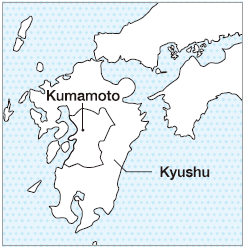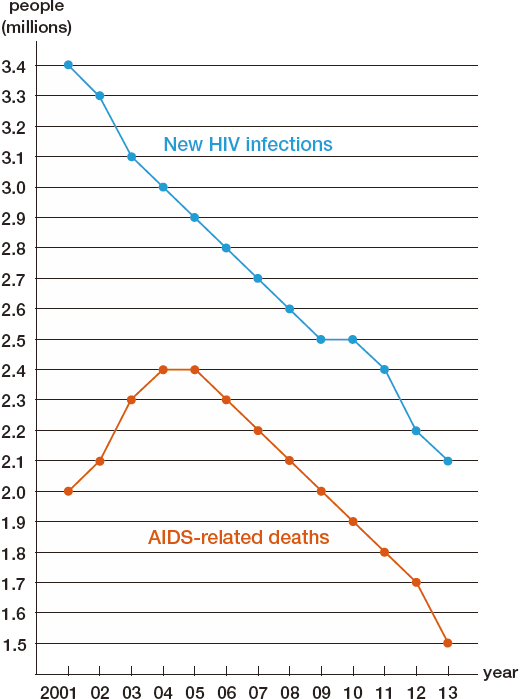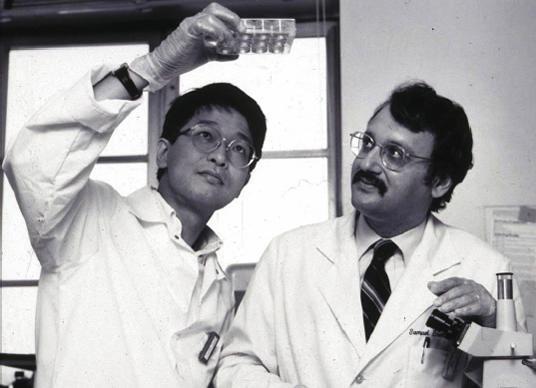When AIDS (acquired immune deficiency syndrome) was recognized by the Centers for Disease Control and Prevention in the United States 33 years ago, it was an untreatable and deadly disease. Dr. Hiroaki Mitsuya, presently serving as professor at the School of Medicine, Kumamoto University, and director of the Center for Clinical Sciences at the National Center for Global Health and Medicine, achieved a dramatic breakthrough in the 1980s by developing the first three drugs that were effective in combating the disease.
AIDS was first reported in the United States in 1981, and HIV (human immunodeficiency virus) was proved to cause the disease subsequently in 1983-1984. Dr. Mitsuya, who had been studying the mechanisms of immunodeficiency at the National Cancer Institute, National Institutes of Health (NIH) in Bethesda, Maryland, began working on the development of drugs to treat patients suffering from HIV infection in 1984. Although Dr. Mitsuya thought that if he were infected with HIV, he would die within years, he thought that somebody had to do it and decided without hesitation to implement the project. While many researchers were reluctant, Dr. Mitsuya felt compelled to fight and potentially win in his lonely battle, since he not only had extensive knowledge about the virus but also had already established immune cells that were highly susceptible to HIV infection. Indeed, prior to going to the United States, Dr. Mitsuya had extensively studied a leukemia virus that is akin to HIV and impacts the human immune system, and thought that he would be able to apply the results of his study in Japan tohis AIDS research in the United States.
He conducted experiments by himself in the laboratory from early morning until late at night, and when he ran short of cells to use for his experiments, he drew blood from his own arm to isolate cells for the experiments and repeated experiments hundreds of times. Within one year, Dr. Mitsuya succeeded in establishing his own evaluation system and identified azidothymidine or zidovudine (AZT), the world’s first effective drug for treating AIDS. Dr. Mitsuya also played a central role in developing the second and third AIDS drugs. In 2007, Dr. Mitsuya also succeeded in developing a new HIV protease inhibitor, darunavir, which played a significant role in the treatment of HIV but with only a few side effects.
These days, combined use of the drugs allows those with HIV/AIDS to extend their lives close to those of uninfected individuals. Moreover, very recently the early initiation of combined antiretroviral therapy has proven to reduce rates of sexual transmission by 96%, nearly 100%. In large part due to his initial breakthrough, AIDS has now been transformed from a deadly disease to one that is chronic but treatable and preventable.
Dr. Mitsuya continues to commute between Japan and the United States pursuing the development of further potent drugs to combat AIDS. His theory that “the more speedy the research, the more patients’ lives can be saved” is based on his own solid belief, and he stresses that “more should be invested in basic medical research.” At the same time, he works hard to train young researchers. He tells them, “Science removes or reduces human suffering and brings about a high quality of life. Scientists pursuing research that makes people healthy and happy is very cool! Attempting to unravel the mysteries of the life sciences is literally a great privileged adventure.” Science continues to benefit from dedicated scientists like Dr. Mitsuya.
Hiroaki Mitsuya
Professor of hematology at the School of Medicine, Kumamoto University since 1997, and director of the Center for Clinical Sciences at the National Center for Global Health and Medicine since 2012. Has previously worked as chief of the Experimental Retrovirology Section of the National Cancer Institute in the United States. Conducts AIDS research in both Japan and the United States.
HIV, which causes AIDS, infects important cells in the “command centers” of the immune system, which protects the body from extemal threats. As the virus multiplies, it causes systemic immunodeficiency and, without treatment, infected patients will die. Antiviral drugs work to limit this propagation. As of 2013, AIDS continues to have a devastating impact, which 2.1 million newly infected patients every year worldwide and annual deaths totaling 1.5 million. As of 2013, according to the UNAIDS Global Plan, there were 35 million AIDS patient worldwide.


































































































































